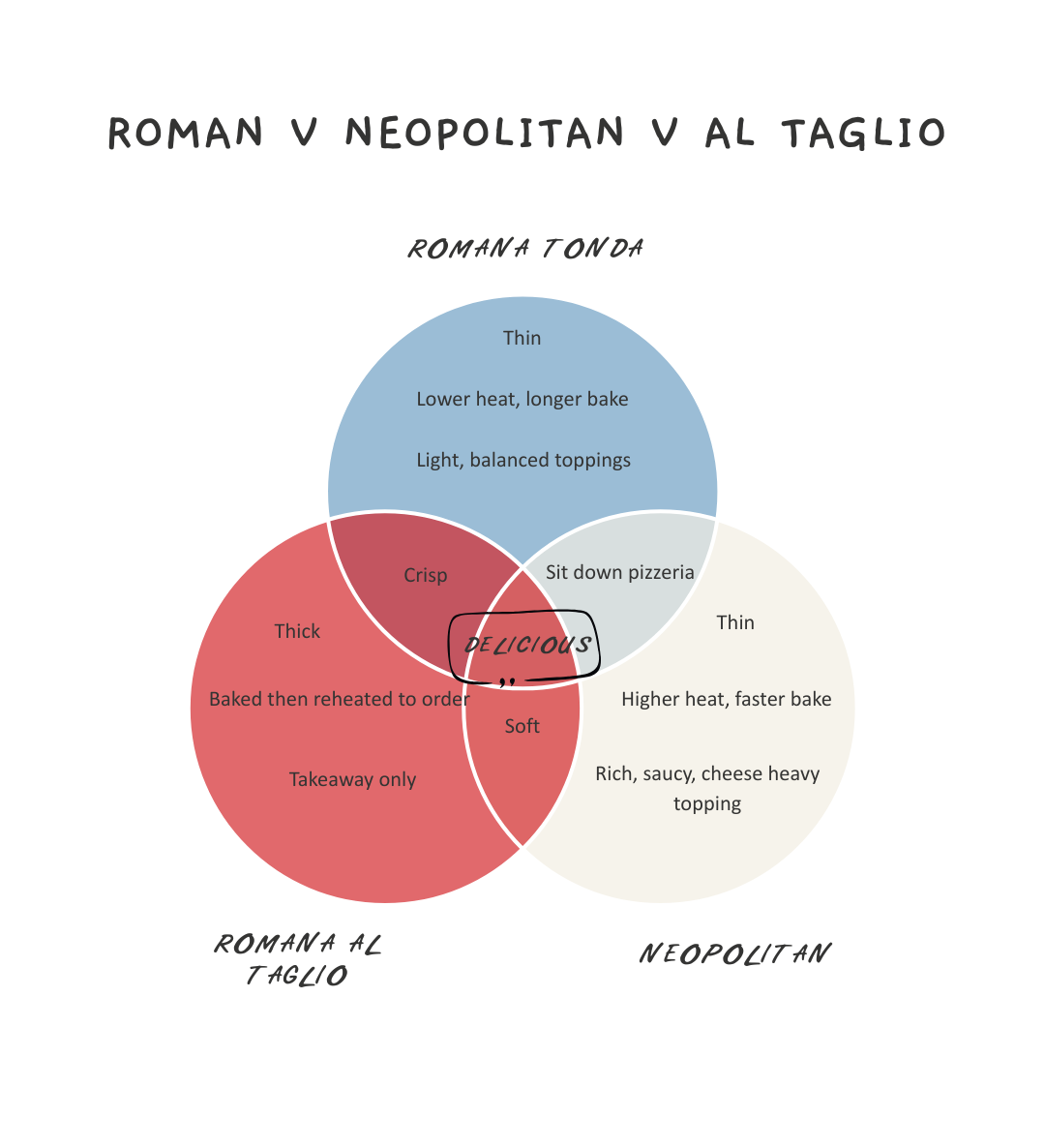Roman vs Neapolitan Pizza: What’s the Real Difference?
At Poco Pizza, we proudly specialise in authentic Roman pizza — not Neapolitan, not New York, not sourdough fusion. Just Roman. But what does that actually mean?
If you’ve ever puzzled over the difference between Roman and Neapolitan pizza — or seen locals in Rome queueing at one spot for takeaway slices, then sitting down across the street for something totally different — you’re not alone.
In this post, we’re breaking down the differences between three key Roman pizza styles:
Roman round pizza served in pizzerias (pizza tonda Romana)
Roman pizza by the slice (pizza al taglio)
And the much better-known Neapolitan pizza that dominates Instagram feeds
The Base – Thin, Thinner, Thick?
Roman Pizza (Pizza Tonda Romana):
This is what we make at Poco. Roman pizza has a thin, crisp base, rolled out into a round (often with a rolling pin) and cooked long and slow compared to its Neapolitan cousin. It’s light, snappy, and holds its shape — no sag, no flop.
Neapolitan Pizza:
Neapolitan bases are soft, airy, and pillowy. They’re cooked at a blazing 450°C+ for just 90 seconds in a wood-fired oven, producing a soft middle and a puffed-up, chewy crust (cornicione) that’s often left bare.
Pizza al Taglio:
This is pizza by the slice, served from giant rectangular trays. The dough is thicker and more focaccia-like, fermented for up to 72 hours for lightness. The base is crispy on the bottom but tender inside, and it's usually sold by weight. It’s also always takeaway or stand-up only — there are no tables, just a counter and a hungry queue.
The Bake – Oven Techniques Matter
Roman round pizza is baked at lower temperatures (around 350 oC), often in an electric or gas oven, for longer than Neapolitan pizzas. The goal is that golden, biscuit-like crunch — a crust that breaks cleanly and supports every bite.
In contrast, Neapolitan pizza relies on very high temperatures (450oC) and wood-fire smoke. The result is a puffed, black-blistered crust and a centre so soft you’ll need to fold it — or eat it with a knife and fork.
Pizza al taglio is often baked in large electric deck ovens with pans of different toppings baking side by side. Slices are reheated to order, which actually sharpens the crust without drying the dough — a clever bit of Roman efficiency.
The Toppings – Keep It Simple, Roman Style
At Poco, our toppings follow Roman tradition: balanced, bold, and light-handed. No overloaded crusts, no cheese waterfalls — just great ingredients in harmony.
Roman round pizza uses minimal sauce, modest cheese, and punchy toppings like anchovies, courgette flowers, or guanciale.
Neapolitan pizza tends to use rich San Marzano tomato sauce and lots of creamy mozzarella — delicious, but heavier.
Pizza al taglio is the most experimental. Toppings range from roasted potatoes and rosemary to smoked provola and pistachio cream — often created in harmony with the slower dough.
The Experience – Sit-Down or Street Food?
A big difference people often overlook is how you eat each kind.
Roman pizzerias (like Poco) offer a full restaurant experience: antipasti, wine, round pizzas straight from the oven, and a relaxed, sociable atmosphere.
Neapolitan pizzerias are similar, though often faster-paced.
Pizza al taglio is fast food with finesse. It’s street food for busy locals — a slice on the go between errands or during a quick lunch break. You’ll see schoolkids, builders, and suited office workers eating shoulder-to-shoulder at the same marble counter.
So, What Makes Poco Pizza Roman?
We don’t just call it Roman-style — we live it.
Our doughs are long-fermented, high hydration, and stretched to that ultra-thin base. We bake low and slow to achieve the perfect crispness, and we honour Roman pizza’s rule of restraint: do less, but do it brilliantly.
When you sit down at Poco, you’re not just getting a great pizza. You’re getting a slice of our time in Rome — from the neighbourhood forno to the streets of Trastevere, where the inspiration for every bite is born.
Frequently Asked Questions - Difference between Roman and Neapolitan pizza
What is the difference between Roman and Neapolitan pizza?
Roman pizza is thin, crisp, and light, baked at a lower temperature for a longer time. Neapolitan pizza has a soft, pillowy crust with a charred edge, baked very quickly in an extremely hot wood-fired oven.
Is Roman pizza healthier than Neapolitan pizza?
Roman pizza tends to be lighter because of its thinner base and more restrained use of toppings. It’s also less doughy, which can make it feel less heavy, especially for lunchtime meals.
What is pizza al taglio?
Pizza al taglio is a Roman-style pizza baked in large rectangular trays and sold by the slice to takeaway. The dough is thicker and airy, and slices are often reheated to order for maximum crispiness.
Where can I find authentic Roman pizza in the UK?
You can experience true Roman-style pizza at Poco Pizza in Lyme Regis. Our pizzas are inspired by our research trips to Rome, using traditional fermentation methods and a thin, crisp base.
Which is better: Roman or Neapolitan pizza?
Both styles are delicious but very different. If you prefer a crispy, light base with balanced toppings, Roman pizza is for you. If you love soft, chewy textures and rich tomato sauce, you might lean towards Neapolitan.





